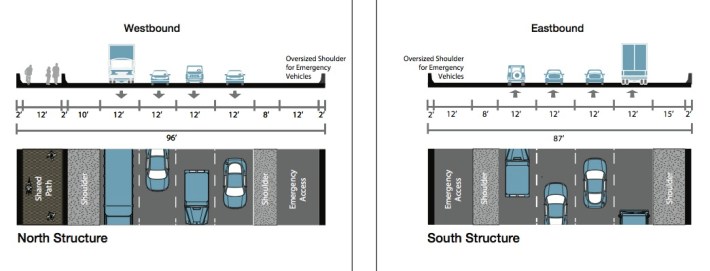
Governor Andrew Cuomo's rushed plans for a transit-free Tappan Zee Bridge are shortsighted and increasingly unpopular. They may also be illegal.
Under federal and state law, the construction of a new Tappan Zee Bridge can't proceed without going through environmental review. The state must analyze and then disclose the impact the project will have on surrounding communities; decision makers and the public alike have a right to be fully informed about the project.
"The DEIS is practically and legally deficient and contrary to the requirements of NEPA and SEQRA"
In official comments submitted Friday, some of the state's top environmental and transportation organizations assert that the Cuomo administration's draft environmental impact statement fails to disclose the required information. Mandatory analyses are either absent or entirely cursory, the groups allege. Clearly, the shadow of a lawsuit now hangs over the Tappan Zee Bridge project.
"The DEIS is practically and legally deficient and contrary to the requirements of NEPA and SEQRA," wrote the conservation group Riverkeeper, referring to the federal and state environmental review laws, respectively, in comments that resembled a legal brief [PDF].
Comments submitted jointly by the Tri-State Transportation Campaign, the Natural Resources Defense Council, NYPIRG, Transportation Alternatives and Good Jobs New York concurred [PDF]. At three separate points, the organizations repeat this phrase: "Without more analysis, the project cannot meet the environmental review requirements."
The groups identify myriad faults with the DEIS. Some of the errors they highlight are technical: Traffic counts change dramatically from one chapter of the DEIS to the next, for example, calling into question the basic math underlying the state's analysis.
Other omissions cut to the very heart of the environmental review process: the public's right to understand the options before them. For example, the groups state that under the law, the state cannot eliminate alternatives from consideration based on cost without providing a rigorous financial analysis of the option being rejected. But state agencies have consistently refused to explain why their cost estimates for bus rapid transit are two to five times higher now than they were just two years ago, even as the Cuomo administration repeatedly invoked budget constraints to justify the elimination of transit from the bridge.
That is not legally acceptable, said Riverkeeper in its comments: "Here, again, the DEIS asks the public to 'trust us'—it merely states these cost estimates without providing any studies or analysis to support these expected costs. To conclude that mass transit is not a reasonable and feasible alternative because 'funding for the Tappan Zee Bridge/I-287 Corridor Project (components including bridge replacement, highway improvements, and new transit service) was not financially feasible at this time' without providing more, constitutes a legally defective decision by lead agencies under SEQRA."
Both sets of comments note that, despite the Cuomo administration's promises, the DEIS offers no concrete assurance of how the new Tappan Zee design will allow for transit to be built at some point. The coalition led by the Tri-State Transportation Campaign lists a series of questions about the bridge's transit-readiness left unanswered by the DEIS. "Are the shoulders – narrowing to 6 feet in one instance near the bridge’s landing – wide enough to accommodate a BRT system?" they ask.
Further, each group questions how a bridge twice as wide as the current Tappan Zee won't lead to more auto traffic, as the state claims. Notes Riverkeeper, "Lead agencies repeatedly use this faulty assumption to short circuit, limit, or wholly avoid studying the environmental impacts to critical components discussed in the DEIS, such as transportation, air quality, energy and climate change, and indirect and cumulative effects. The complete failure to properly study these vital environmental impacts renders the DEIS legally defective."
Each organization calls on the state to produce additional environmental analysis to rectify the gaps in its statements so far.
Finally, both sets of comments note that the state has not adequately analyzed the effect of construction on populations of Atlantic and shortnose sturgeon, both endangered species. It's worth recalling that the first Governor Cuomo's dreams of building a highway by the Hudson, known as Westway, were finally derailed by his administration's own faulty environmental review. A federal court ruled that the state hadn't taken account of Westway's impact on striped bass. The highway project died and the money was used to save the transit system instead.





